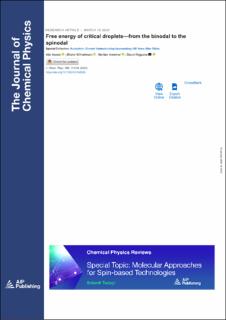| dc.contributor.author | Aasen, Ailo | |
| dc.contributor.author | Wilhelmsen, Øivind | |
| dc.contributor.author | Hammer, Morten | |
| dc.contributor.author | Reguera, David | |
| dc.date.accessioned | 2024-01-11T15:46:13Z | |
| dc.date.available | 2024-01-11T15:46:13Z | |
| dc.date.created | 2023-03-30T12:51:52Z | |
| dc.date.issued | 2023 | |
| dc.identifier.issn | 0021-9606 | |
| dc.identifier.uri | https://hdl.handle.net/11250/3111187 | |
| dc.description.abstract | Arguably, the main challenge of nucleation theory is to accurately evaluate the work of formation of a critical embryo in the new phase, which governs the nucleation rate. In Classical Nucleation Theory (CNT), this work of formation is estimated using the capillarity approximation, which relies on the value of the planar surface tension. This approximation has been blamed for the large discrepancies between predictions from CNT and experiments. In this work, we present a study of the free energy of formation of critical clusters of the Lennard-Jones fluid truncated and shifted at 2.5σ using Monte Carlo simulations, density gradient theory, and density functional theory. We find that density gradient theory and density functional theory accurately reproduce molecular simulation results for critical droplet sizes and their free energies. The capillarity approximation grossly overestimates the free energy of small droplets. The incorporation of curvature corrections up to the second order with the Helfrich expansion greatly remedies this and performs very well for most of the experimentally accessible regions. However, it is imprecise for the smallest droplets and largest metastabilities since it does not account for a vanishing nucleation barrier at the spinodal. To remedy this, we propose a scaling function that uses all relevant ingredients without adding fitting parameters. The scaling function reproduces accurately the free energy of the formation of critical droplets for the entire metastability range and all temperatures examined and deviates from density gradient theory by less than one kBT. | en_US |
| dc.language.iso | eng | en_US |
| dc.publisher | AIP Publishing LLC | en_US |
| dc.rights | Navngivelse 4.0 Internasjonal | * |
| dc.rights.uri | http://creativecommons.org/licenses/by/4.0/deed.no | * |
| dc.title | Free energy of critical droplets - From the binodal to the spinodal | en_US |
| dc.title.alternative | Free energy of critical droplets - From the binodal to the spinodal | en_US |
| dc.type | Peer reviewed | en_US |
| dc.type | Journal article | en_US |
| dc.description.version | publishedVersion | en_US |
| dc.source.pagenumber | 0 | en_US |
| dc.source.volume | 158 | en_US |
| dc.source.journal | Journal of Chemical Physics | en_US |
| dc.source.issue | 11 | en_US |
| dc.identifier.doi | 10.1063/5.0142533 | |
| dc.identifier.cristin | 2138482 | |
| dc.relation.project | Norges forskningsråd: 262644 | en_US |
| cristin.ispublished | true | |
| cristin.fulltext | original | |
| cristin.qualitycode | 1 | |

